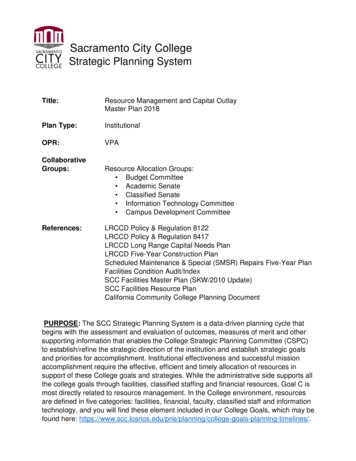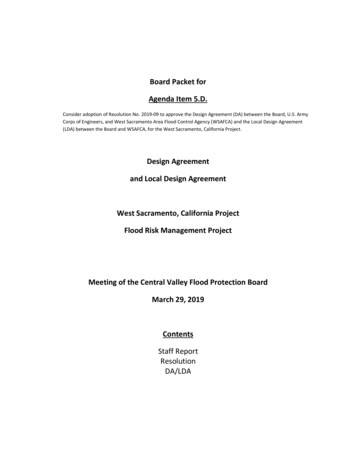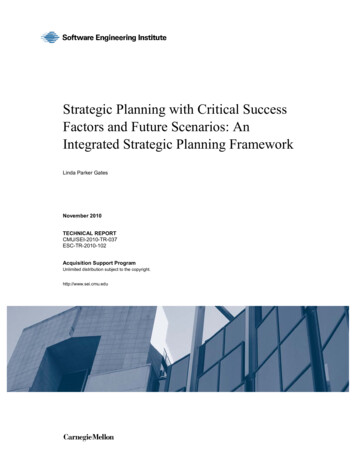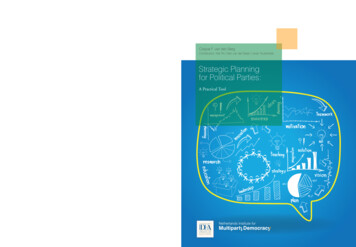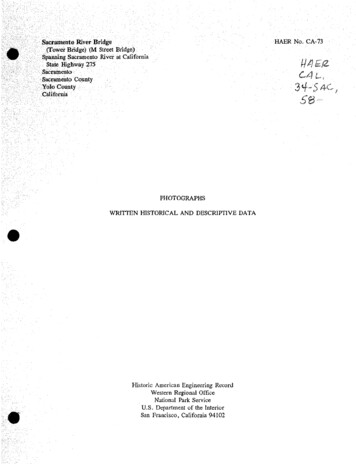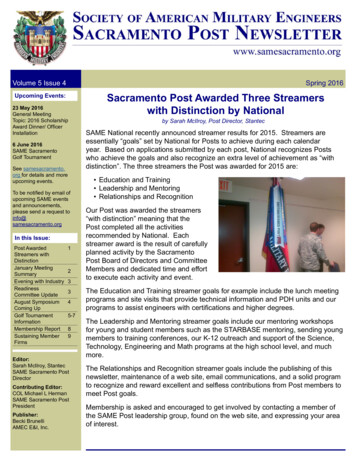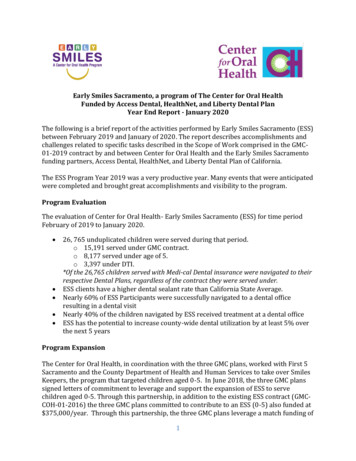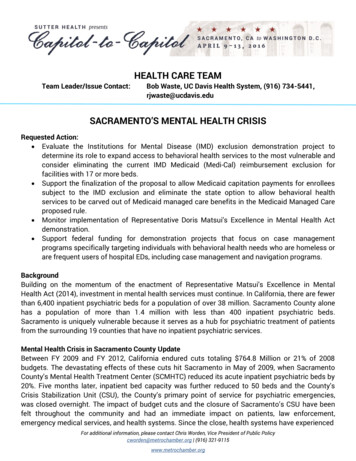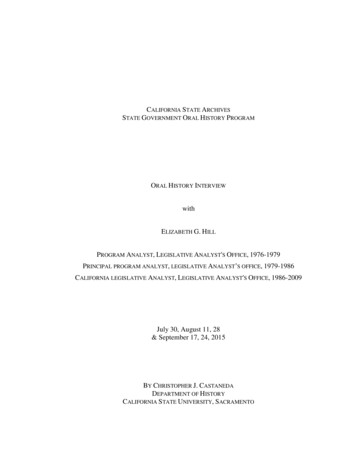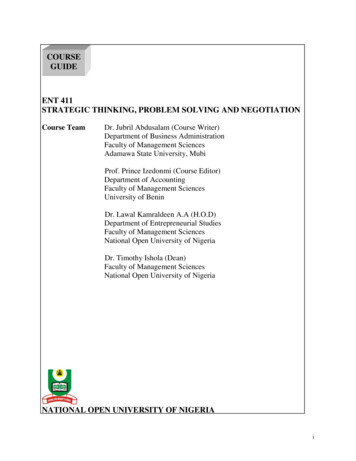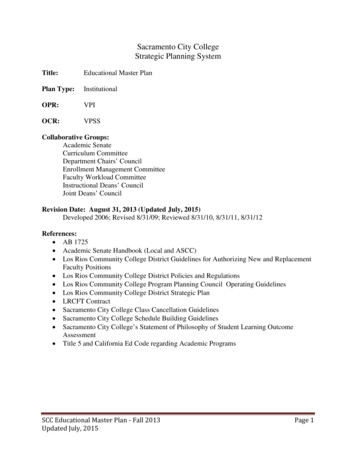
Transcription
Sacramento City CollegeStrategic Planning SystemTitle:Educational Master PlanPlan Type:InstitutionalOPR:VPIOCR:VPSSCollaborative Groups:Academic SenateCurriculum CommitteeDepartment Chairs’ CouncilEnrollment Management CommitteeFaculty Workload CommitteeInstructional Deans’ CouncilJoint Deans’ CouncilRevision Date: August 31, 2013 (Updated July, 2015)Developed 2006; Revised 8/31/09; Reviewed 8/31/10, 8/31/11, 8/31/12References: AB 1725 Academic Senate Handbook (Local and ASCC) Los Rios Community College District Guidelines for Authorizing New and ReplacementFaculty Positions Los Rios Community College District Policies and Regulations Los Rios Community College Program Planning Council Operating Guidelines Los Rios Community College District Strategic Plan LRCFT Contract Sacramento City College Class Cancellation Guidelines Sacramento City College Schedule Building Guidelines Sacramento City College’s Statement of Philosophy of Student Learning OutcomeAssessment Title 5 and California Ed Code regarding Academic ProgramsSCC Educational Master Plan - Fall 2013Updated July, 2015Page 1
EDUCATIONAL MASTER PLANTable of ContentsPagePurpose 5Institutional Overview .5Background .5Mission, Vision, Values 5Strategic Goals .6Overview of the Integrated Planning Process . .8Data for PlanningUnit Plans and Resource RequestsProgram ReviewParticipatory Governance and Instructional Services Processes . 15Academic SenateCenters and Educational PlanningClass Cancellation CriteriaCurriculum ProcessDepartment ChairsFaculty Allocation and Hiring ProcessNew Program DevelopmentSchedule Building GuidelinesScheduling Process and Allocation of FTEFStudent Learning Outcomes in Curriculum & Academic PlanningKey Issues for Planning . 22AccessAccountabilityBasic SkillsCalifornia Community College System GoalsCareer Technical EducationCivic Learning/Global CitizenshipDeclining State Support for Public Higher EducationDemographicsDistance EducationInternational StudentsPedagogical ChangeSacramento Pathways to Success – A Partnership for College to CareerStrengths, Weaknesses, Opportunities & ChallengesSuccession PlanningSustainabilityTechnology TrendsSCC Educational Master Plan - Fall 2013Updated July, 2015Page 2
Themes for the Future . . 34Organization of Instructional Programs . 36Division and Department Goals and Long-Range Plans . . 40Advanced Technology . 40Advanced TransportationCosmetologyEngineering Design TechnologyElectronics TechnologyGraphic CommunicationMechanical Electrical TechnologyPhotographyTechnology Computer LabBehavioral & Social Sciences . . 47Administration of JusticeAnthropologyGeographyEarly Childhood Education, Family & Consumer Science and GerontologyHistory, Political Science, and Social ScienceInternational StudiesPsychologySociologyBusiness & Computer Information Science . 55Accounting, Business, Business Technology, Economics, Management,Marketing, and Real EstateComputer Information ScienceCounseling . 58Cooperative Work Experience & Internship ProgramDisabled Students’ Programs & ServicesHuman Career DevelopmentDavis Center . 59Humanities & Fine Arts . 60ArtCommunication and HumanitiesForeign LanguagesMusicPhilosophySign Language StudiesTheater Arts and FilmKinesiology, Health and Athletics . . 65Language and Literature . 66EnglishEnglish as a Second LanguageJournalismReadingSCC Educational Master Plan - Fall 2013Updated July, 2015Page 3
Learning Resources Learning, Tutoring and Academic TechnologyLibraryMathematics, Statistics and Engineering .EngineeringMathematics & StatisticsScience and Allied Health Astronomy, Geology & PhysicsBiologyChemistryDental AssistingDental HygieneNursingOccupational Therapy AssistantPhysical Therapist AssistantWest Sacramento Center . .SCC Educational Master Plan - Fall 2013Updated July, 201569767886Page 4
PURPOSEThe Educational Master Plan is a part of the Sacramento City College (SCC) Strategic Planningsystem, a data-drive planning cycle that begins with the assessment and valuation of outcomes,measures of merits, and other supporting information that enable the College Strategic PlanningCommittee (CSPC) to establish/refine the mission and strategic direction of the institution andestablish strategic goals and priorities for accomplishment. The Educational Master Plan (EMP)is one of three institutional plans (the Education Master Plan, the Resource Management andCapital Outlay Plan, and the Student Support Services Plan) that articulate the context and scopeof planning in each college service area. This plan describes the instructional functions of thecollege and how they are coordinated within the strategic planning system, the academicprograms of the college and their functions within the college structure, and the processes bywhich planning is done in the academic areas. It also describes resource needs for instructionalprograms at the college.INSTITUTIONAL OVERVIEWBackgroundSacramento City College (SCC) is one of four colleges within the Los Rios Community CollegeDistrict (LRCCD) serving the greater Sacramento region which has a population of nearly 2.5million. The region is the fourth largest metropolitan area in California. Sacramento City Collegeis located in Sacramento, the capital of the State of California. The city, with an estimatedpopulation of nearly 500,000, is the largest city in a six county region and the sixth-largest city inthe state. In 2002, the Civil Rights Project at Harvard University names Sacramento asAmerica’s Most Diverse City and Sacramento County continues to be one of the most diversecounties in the country. The non-Hispanic white population of Sacramento has been in declinesince the 1940's. Although in 1940, 94% of the population was white, it currently has declined to34.5%. In contract, both the Asian and Hispanic populations are experiencing significantgrowth. In addition, Sacramento has one of the highest LGBT populations per capita, ranking 7thamong major U.S. cities and third in California.Located near downtown Sacramento, SCC serves a diverse population in the cities ofSacramento, West Sacramento, and Davis. Founded in 1916, Sacramento City College will becelebrating its 100th anniversary in 2016. It is the seventh oldest public community college inCalifornia and the oldest institution of higher learning in Sacramento. The College operates twooutreach centers, one in West Sacramento located adjacent to the City of West Sacramento CivicCenter and one in Davis in the University of California, Davis West Village. The Davis Center isthe only community college center operating on a University of California campus.MissionSacramento City College is an open-access, comprehensive community college, serving adiverse student population. We provide a wide range of educational opportunities and supportservices leading to transfer, career advancement, basic skills development, degree and certificateattainment, and personal enrichment. Our commitment to continuous improvement throughoutcome-guided assessment, planning, and evaluation promotes student learning. Through theseefforts, we contribute to the intellectual, cultural, and economic vitality of the community.SCC Educational Master Plan - Fall 2013Updated July, 2015Page 5
VisionSacramento City College seeks to create a learning community that celebrates diversity, nurturespersonal growth, and inspires academic and economic leadership.ValuesWorking Together – Pursuing Excellence – Inspiring AchievementGoals/StrategiesSCC Goal A: Deliver student-centered programs and services that demonstrate acommitment to teaching and learning effectiveness and support student success in theachievement of basic skills, certificates, degrees, transfer, jobs and other studenteducational goals.Strategies:A1. Promote the engagement and success of all students, with a special emphasis on first-yearstudents who are new to college.A2. Review courses, programs and services and modify as needed to enhance studentachievement.A3. Provide students with the tools and resources that they need to plan and carry out theireducation, complete degrees and certificates, and/or transfer.A4. Improve basic skills competencies in reading, writing, math, and information andtechnological competency across the curriculum in order to improve student preparednessfor degree and certificate courses and for employment.A5. Deliver services, curriculum, and instruction that result in equivalent student outcomes forall modalities and locations.A6. Identify and disseminate information about teaching practices and curriculum that areeffective for a diverse student body.A7. Implement practices and activities that reduce achievement gaps in student success.A8. Assess student learning at the course, program, and institutional levels and use thoseassessments to make appropriate changes that support student achievement.A9. Implement a formal college-wide plan to increase the completion of degrees andcertificates across the college.A10. Ensure that students have opportunities to be involved in a range of co-curricular activities.SCC Goal B: Align enrollment management processes to assist all students in movingthrough programs from first enrollment to completion of educational goals.Strategies:B1. Revise or develop courses, programs, schedules and services based on assessment ofemerging community needs and available college resources.B2. Use quantitative and qualitative data to identify strategies which improve enrollmentmanagement processes.B3. Explore and create multiple ways to disseminate information to students in order to engagethem with learning in the college community.SCC Educational Master Plan - Fall 2013Updated July, 2015Page 6
B4. Support “front door” policies and practices that assist students with the transition tocollege.B5. Maintain the quality and effectiveness of the physical plant in order to support access andsuccess for students (i.e. modernization, TAP improvements, equipment purchases, etc.).B6. Expand interactions with community and industry partners in order to increase studentopportunities for experiences that help them transition to careers (career exploration,completion of licenses, internships, etc.)B7. Provide students with clear pathways to goal completion.B8. Provide programs and services that help students overcome barriers to goal completion.SCC Goal C: Improve organizational effectiveness through increased employeeengagement with the college community and continuous process improvement.Strategies:C1. Review staff processes, including those for hiring, orientation, training, customer service,evaluation and professional development and modify as needed in order to make themmore effective and inclusive.C2. Build and maintain an effective staff that reflects the diversity of our students andcommunity.C3. Promote health, wellness and safety throughout the institution.C4. Utilize quantitative and qualitative data to help guide decision-making throughout theinstitution.C5. Increase the effectiveness of communication both within the college and between thecollege and the external community.C6. Continue to exercise transparent and fiscally sound financial management.C7. Encourage collegiality, connection, and participatory decision-making at the college.SCC Educational Master Plan - Fall 2013Updated July, 2015Page 7
OVERVIEW OF INTEGRATED PLANNING PROCESSINSTRUCTIONAL PROGRAMS AND COLLEGE PLANNINGSCC’s strategic planning process occurs through an annual cycle of evaluating data, settinggoals, identifying objectives, allocating resources, implementing the plan, and evaluating results.This cycle begins early in the fall semester and is completed by the end of the spring semester.The instructional programs at SCC intersect the overall planning system of the college at everylevel. Below is a summary of the Strategic Planning System at the college:Planning CycleDATA EVAL SLOs / sMetricsProgramReviewAug/SeptOverview, Timelines, and Key ComponentsStrategicMaster PlanStrategicGoals &Directions SetFamily of PlansObjectives SetResource NeedsDefinedResourceAllocationPlanImplementation1 July 20XXFEEDBACKSep/OctOct/AprOUTCOMESMay/JunSCHEDULE OF EVENTSIllustrated from left to right in the above chart, planning for the instructional divisions anddepartments at the college will begin with evaluation of data in conjunction with the college’sstrategic goals and directions to form objectives that will enable the college to accomplish itsgoals. These objectives are first articulated in the department’s or division’s unit plan, andrequired resources – financial, facilities, faculty, classified staff, and or information technology –SCC Educational Master Plan - Fall 2013Updated July, 2015Page 8
are requested through the appropriate resource plan. The “family of plans” referenced in theprevious chart is illustrated by the following graphic.SCC FAMILY OF PLANSThis strategic planning process includes both broad directions and specific college goals andobjectives encompassing both strategic and operational planning. There are four different typesof plans included within this comprehensive master plan framework: institutional, program,operational unit, and resource allocation. These four types of plans are described as the “familyof plans.”Strategic Master PlanInstitutionalPlansEducational Master PlanResource Management &Capital Outlay PlanStudent Equity PlanProgramPlansUnit PlansResourcePlansStudent Support ServicesMaster PlanStudent Success andSupport ProgramsPlanPlans for programs that support college-wide activities and initiatives. These plans linkdirectly to resource allocation through “Above the line” funding. Examples include:Distance Education, Tutoring, Information Technology, Staff Development, etc.Department-level action plans that guide the daily work of college units. These plans linkdirectly to resource allocation through unit base budgets and Budget Committee funding.Past unit plans inform program review and program review informs future unit plans.FinancialFacilitiesSCC Educational Master Plan - Fall 2013Updated July, e 9
The institutional plans define the context and the scope of planning in each of the threefunctional areas – student services, instruction, and administration – as well as student equity andstudent success. The program plans identify the college objectives and initiatives, the outcomemeasures, and the resource requirement for achieving these outcomes. The operational unit plansaddress both new initiatives and maintenance of effort and define the objectives, outcomemeasures, and resources needed to accomplish objectives at the unit level that support the collegestrategic direction and goals The resource plans define the process for obtaining input, criteriafor prioritizing, and the recommendations for resource allocation.Each step in the plan process relies on data. For example, the District Strategic Plan relies ondistrict trend analysis; SCC Strategic Plan on institutional effectiveness data; Institutional Plansand Resource Plans on institutional and resource metrics; Program Plans on program metrics;Program Review on program data and student learning outcomes; and, Unit Plans on unitobjectives and student learning outcomes. Data utilized for planning will be described in furtherdetail in a following section.Some resources for instructional needs will go beyond the scope of one department or unit due tothe need being college-wide. For example, Distance Education crosses all divisions anddepartments. Although departments may address distance education needs in their individual unitplans, the primary planning for college-wide needs occurs through the program plans (ex.,Distance Education, Information Technology, etc.) and resources are requested through thoseplans as well.Once resources are allocated, outcomes of the objectives are evaluated based on measures ofmerit established when the objectives were first proposed. These measures indicate relativesuccess of the projects and also become part of the feedback that the unit can evaluate for thenext planning cycleData for PlanningStudent Learning Outcomes assessment data is but one course of information used ininstructional planning. Departments and divisions use college-wide student achievement data(course completion, persistence, graduation, transfer, and other data) and accountability data(ARCC report, ACCJC report, and others) as well as data sets that are determined at the divisionor department level to plan objectives for improvement in their particular areas. The data, inconjunction with college goals, start the planning process are the focus of discussion in thedepartment and division meetings. Based on that discussion, units write focused objectives fortheir areas (unit planning). Every six years, they consider the data when evaluating their classesand academic programs (Program Review). This data, a common core of key effectivenessindicators, includes the following:Demographics: Enrollments by gender, ethnicity, and age group for department,division, and college – five year trend data (fall semesters)Student Success: Successful course completion rates (number of A, B, C, and Creditgrades divided by all grades) for department, division, and college – five year trend data(fall semesters)SCC Educational Master Plan - Fall 2013Updated July, 2015Page 10
Productivity: Weekly student contact hours (WSCH) divided by FTE for department,division, and college – five year trend data (fall semesters)Enrollment: Weekly student contact hours for department, division, and college – fiveyear trend data (fall semesters)Unit Plans and Resource RequestsAcademic departments review their programs on a yearly basis and plan for the coming yearthrough the Unit Plan and Resource Request process. The department yearly review includes, butis not limited to, an analysis of: Student Profile Data (ex., student achievement, student demographics, enrollment, etc.) Student Learning Outcomes Assessment Community and Industry Needs (includes transfer information and job placement)Following review of appropriate data, the department develops a plan to address their findingsand designs their unit plan objectives to strategically address fulfillment of college goals. Unitplan objectives may represents activities/projects conducted in a single year or carried throughmultiple years.Unit PlanningPrioritization Process and CriteriaAlthough most unit plan objectives within Instructional Services start at the department level,division offices and the Office of Instruction also complete unit plans with objectives. Whendepartments complete their objectives, they prioritize them within their unit plan. The objectivesfor all the departments within an instructional division and the division office are thencollaboratively prioritized at the division level. Finally, objectives prioritized by the departments,the divisions, and the Office of Instruction are submitted for ranking by the Instructional CollegeService Area (CSA). Because of the size of the Instructional CSA, only the top ten objectivesfrom each area are considered for the CSA ranking. All instructional managers review thesubmitted objectives and score them using the following rubric and process:Ranking Instructions for Instructional Services (CSA) Unit Plan ObjectivesAfter department chairs and instructional deans have worked together to prioritize objectives atthe division level, a consolidated list will be constructed for VPI discussion with division deansand AVPs.The following criteria will be used to score the objectives to achieve the CSA ranking: Support for College Goals: The objective clearly supports a college goaland will move the college forward in achieving that goal, the strategicdirections of the college, and the college mission. Important Initiative or Unit Need: The objective is tied to an importantcampus initiative, or it articulates a critical need (either new ormaintenance of effort) of the unit.SCC Educational Master Plan - Fall 2013Updated July, 2015Page 11
Clarity for Evaluation: It is clear how the objective will be evaluated forcompletion and for program improvement.The strongest objectives will very clearly meet all three criteria. Weaker objectives mayhave merit but will not be as clearly tied to college goals, strategic directions, and unitneed—and/or may not be clear in how they will be evaluated for completion.Using the above criteria, individuals will provide each objective with a score from 1(does not meet the criteria) to 10 (strongly meets the criteria).12345678910Does NotMeet CriteriaStronglyMeets CriteriaOnce individuals have scored each unit objectives, the scores will be sent to the InstructionOffice. A composite score for each objective will be tallied. The highest possible score wouldequal 10 x # of individuals scoring and the lowest would be 1 x # of individuals scoring. Thehighest score will be ranked #1, next highest #2, etc. Prior to conversion of the composite scoresto a ranked list (1, 2, 3, 4, etc.), the VPI will determine the priority order for any objectives withthe same composite scores (ex., 3 objectives with a score of 112). Scores will then be convertedto a ranked numerical listing (1 through 110, or maximum # of objectives ranked) that does notinclude any ties.Discussion and Scoring Process:Each Instructional Division Dean and the Vice President of Instruction are provided ten minutesto present and answer questions on the top ten objectives from their areas. Each instructionalmanager then scores the objectives according to the above rubric and submits their scoring sheetsto the administrative assistant for the Vice President of Instruction. This individual tallies thescores and puts them into numerical order. In cases of tie scores, the VPI assigns the ranking tothe objectives. Once this process is completed, the VPI submits a prioritized list of objectives tothe Dean of Planning, Research, and Institutional Effectiveness. The results are then distributedto the departments, divisions, and utilized in the Resource Allocation Process by the BudgetCommittee.Beginning in Fall 2014, the Instructional Services Area will expand the ranking of items toensure that the objectives ranked include the top ten objectives with an identified fiscal need thatwill be sent to the Budget Committee for consideration. This will ensure that the BudgetCommittee has information from the College Service Area.Outcome MeasurementAchievement of strategic plan goals, strategies, and objectives is measured throughaccomplishment of planned activities, as measured by program faculty and staff. Departments,divisions, and CSA’s are given flexibility in determining progress towards identified objectivethrough both quantitative and/or qualitative methods. Assessment and analysis of achievementSCC Educational Master Plan - Fall 2013Updated July, 2015Page 12
and outcome measures reflecting progress towards identified objectives is conducted andreported annually. This information is utilized to measure progress in meeting the college’s goalsand strategies.Program ReviewEvery six years, on a rotating basis, academic departments undergo Program Review. In thisprocess, the departments conduct a comprehensive review looking at strengths, areas needingimprovement, follow-up items for the department’s unit plan, and anticipated implications andresources for course specific demographics, student success, enrollment, productivity, andstudent learning outcomes. Program faculty also review all degrees and/or certificate curriculumby answering the following questions: How does the degree and/or certificate prepare students for transfer and/or theworkforce? What changes have been made to the program since the last program review cycle? Are any changes planned for the course sequence, pre-requisites, or electives of theprogram? If so, please describe. What changes are planned to meet the needs ofemployers or transfer institutions? What changes were suggested during the last update ofthe curriculum outline? Are any new degrees and/or certificates planned – e.g. AA-T orAS-T degrees? What are the latest Curriculum Committee approval date for degrees and certificates How many students have declared the program/certificate as their majors and how manydegrees/certificates have been awarded during the past six years? What are results of the program SLO (ProLO) assessments and what do they mean for theprogram’s strengths, challenges, plans, and future resource needs. Summarize the types of skills and abilities (i.e. Program SLOs) at which studentsexcel and those with which they struggle. What are the strengths and the areasneeding improvement? Summarize changes that have been made or are planned, based on Program SLOassessments, including changes to course assignments, class materials, prerequisites,teaching methods, etc. Note any follow up items for the department’s Unit Plan andanticipated resource implications (ex., budget, staffing, sabbaticals or reassigned timerequests, facilities, or curriculum proposals). Career technical education programs also address student placement and success.In addition, program faculty review all courses, certificates and degrees in their currentcurriculum; update and revise the curriculum as necessary; and write any new curriculum toaugment their offerings and better serve the SCC student population.In addition to the comprehensive six year program review, all career technical educationprograms are evaluated every two years as mandated by the California Education Code, Section78016. Programs evaluate labor market information data regarding annual average employment,employment change, average annual openings, and wages and training. Student technical skillattainment, completions, persistence and transfer, placement, and equity are also evaluated. Theacademic divisions that have career technical education programs are Advanced Technology,SCC Educational Master Plan - Fall 2013Updated July, 2015Page 13
Business and Computer Information Science, Behavioral and Social Sciences (Family andConsumer Sciences, Early Childhood Education, and Nutrition), Learning Resources (Libraryand Information Technology), and Science and Allied Health (Dental Assisting, Dental Hygiene,Nursing – Registered and Vocational, Occupational Therapy Assistant, and Physical TherapistAssistant).SCC Educational Master Plan - Fall 2013Updated July, 2015Page 14
PARTICIPATORY GOVERNANCE ROLES AND INSTRUCTIONAL SERVICESPROCESSESAcademic SenateAccording to Title 5 §53200 of the California Education Code, the primary function of theAcademic Senate is to make recommendations with respect to academic and professionalmatters. The SCC Academic Senate is the faculty source for college, district, and sharedgovernance information. Each division on campus elects Senate representatives from both fulltime and adjunct faculty based on FTE formulas. It is the Senators’ responsibility to be aninformation conduit between their divisions and the Senate and act on behalf of the divisionfaculty they represent. Per Title 5, the faculty are actively engaged in curriculum; degree andcertificate requirements, grading policies; educational program development; establishingstandards regarding student preparation and success; governance; accreditation; professionaldevelopment; program review; institutional planning and budget development; and othermutually agreed upon academic and professional matters.Centers and Educational PlanningSacramento City College’s Centers in Davis and West Sacramento are the focus of educationalplanning as well as active participants in the planning process. The deans for these Centersdevelop unit plans that contain educational objectives as well as other objectives to meet thespecific needs of the Centers. The Centers offer classes from every division at the college, soplanning their schedules, their various services (ex., counseling, financial aid, tutoring, etc.), andtheir facility needs for growth and expansion is a coordinated effort between the Center deans,the constituencies on the main campus, and the District Office.Class Cancellation CriteriaClasses are sometimes cancelled because of low enrollments. The criteria for class cancellationshave been agreed upon with the Academic Senate and are periodically reviewed by the deans,department chairs, and Faculty Workload Committee. These decisions are made by the divisiondean in consultation with the department chair. The criteria for deciding if a class should becancelled include the number of students on the class roster, historical enrollments in the class,likelihood of meeting maximum enrollment by the first week of the term, options for students ifthe course if cancelled, and impact on the program from the cancellation. Whenever a class isremoved from the schedule, an attempt is made to find alternative classes for any enrolledstudents.Curriculum ProcessCurriculum is the primary responsibility of the faculty, therefore, the process for developing newcurriculum or revising existing curriculum starts at the department level. Curriculumdevelopment can be part of Program Review or it can be generated by an individual facultymember.
Sacramento City College (SCC) is one of four colleges within the Los Rios Community College District (LRCCD) serving the greater Sacramento region which has a population of nearly 2.5 million. The region is the fourth largest metropolitan area in California. Sacramento City College is located in Sacramento, the capital of the State of California.
